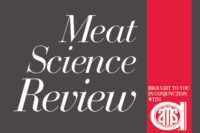Shelf life and shelf stability are two important characteristics for many of today’s meat and poultry products. Before the advent of refrigeration, both shelf life and shelf stability were needed and regularly implemented to safely extend the storage life of otherwise perishable meat and poultry products. Because of the harsher approach (e.g. high salt concentrations, very dry product, etc.) to implementing preservation methods before refrigeration, a product that had a long shelf life was also likely shelf-stable and vice versa. Today, because products are more refined and refrigeration exists, shelf life and stability have become more important for the economic benefit that results from a product having a longer storage life and for creating safe, convenient products.
Shelf stability is the state of a product in which certain intrinsic product conditions are created where the support of bacteria, focusing on the pathogenic variety, does not exist which allows for non-refrigerated storage. There are a number of preservation methods available for achieving shelf stability and it should be noted that sterilization (canning) is included in that list. Concentrating on pasteurized products, shelf stability is achieved by targeting and manipulating the factors that prevent bacteria from growing. There are a number of physiological requirements, scientifically known, that are critical to inhibiting bacterial growth. Factors include:
- pH (acidity of the product)
- water activity (amount of water in a product available for a microorganism)
- salt (directly impacts the water activity)
- atmosphere (the presence of oxygen or other gases)
- antimicrobial (providing a synergistic ability to interact with other physiochemical factors)
Shelf life is defined as the amount of time (in days) during which microbial and chemical changes are delayed long enough to extend the post processing life of a product to the fullest extent. It should be noted that shelf life not only describes quality deterioration but also is a metric for food safety. For certain products — such as fully cooked, ready-to-eat products — shelf life is used to determine the effectiveness of antimicrobials for controlling the growth of pathogens such as Listeria monocytogenes.
As with shelf stability, shelf life is also affected by a variety of intrinsic factors in addition to a number of extrinsic factors. Coincidentally, many of the factors that influence shelf stability also affect shelf life. In addition to the factors previously listed, others include:
- the microbial quality of raw materials (especially for raw products)
- the chemical quality of the raw materials (especially fat quality)
- the addition of antimicrobial or antioxidant ingredients
- processing or post-processing product contamination
- robustness of sanitation program
- processing and/or finished product storage temperature
Both shelf life and shelf stability can be summarized as approaches for creating a product with significant gains from safety and economical perspectives. Although both can be technically challenging to achieve, success with each are attainable and provide new opportunities for product creation, development and performance. NP




Report Abusive Comment